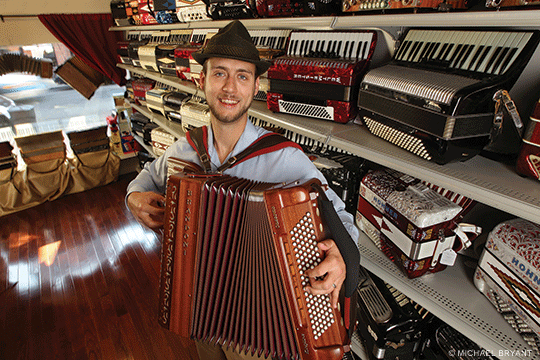Class of ’07 | Just about everyone who ventures into Liberty Bellows in Philadelphia’s Queen Village neighborhood falls under the spell of its singular product. Maybe that’s because the product—the accordion—comes laden with nostalgia, kitsch, and multi-cultural cred. More likely, it’s due to the earnest enthusiasm of the store’s lanky owner, Michael Bulboff G’07 GrW’12. Standing amidst squeezeboxes of all vintages and price points, he patiently answers questions and details the history of this incredibly adaptable and portable instrument, which was invented in 19th-century Vienna, earned a place in the repertoires of ethnic music around the world, became a staple of vaudeville, and fell out of favor with the advent of rock and roll.
Always, he sings its praises. “It can change the mood of a song better than anything else,” he says. “It can present a dark biting sound, a whimsical carnival effect, or a joyful celebration.”
Strapping on a new black Weltmeister piano accordion that retails for $3,800, he demonstrates. Starting slowly, he coaxes the instrument into a sultry tango, then speeds up a bit into a harmonica-like lilt that sounds Indian. Next, he’s shaking his accordion with every fold, eliciting the vibrating effect favored by Slavic players before switching to the piercing sweetness of “O Sole Mio.”
Bulboff’s obsession with a quirky instrument beloved by gypsies and polka-dancers, klezmer-players and Lawrence Welk, has been longstanding. But it only reached a crescendo two years ago. Lately, the 32-year-old Bulboff has started a kids’ accordion camp and an accordion club—all part of his plan to build what he calls an “infrastructure” for accordion aficionados that goes beyond the repairing and selling that consumes most of his five-person staff’s time. (In addition to piano, chromatic, and diatonic accordions, Liberty Bellows also buys, sells, trades, rents, and repairs concertinas, bandoneons, and “other free reed instruments,” according to its website, libertybellows.com.)
Running up and down the steps of a three-story building, from showroom to classroom to stockroom, wasn’t always in the cards. After earning his bachelor’s degree in computer science from Princeton, Bulboff found work in the actuarial and risk-management fields before entering Wharton to pursue a doctorate in applied economics. All along, the accordion called to him—but casually. He’d first picked up the instrument as a teenager after discovering one that his late father—a former Mummer in the Duffy String Band—had owned. Piano and flute lessons had failed to hold his interest, but the accordion offered the best of both of those worlds: keyboard and reeds.
“Even back then, though, I always wondered why more people didn’t take it up,” he says. About five years ago, he noticed that interest in the accordion was rising, thanks to its prominence in the music of hipster bands like Arcade Fire and They Might Be Giants—and that there weren’t enough places for people to turn to when they needed repairs or wanted to learn more. “It was the exact opposite of what I was finding to be true in academia, where there was a lot of supply and not enough demand,” Bulboff says, a dimple appearing as he smiles.
He decided to leave Wharton with just his master’s degree (in applied statistics)—and to indulge his true passion, which was “buying and selling accordions, instead of stocks.” He found a storefront, then moved to a larger space to accommodate a growing inventory of used accordions. “I never say no to anything that seems to have potential,” he says. “You take a chance, you fix them up, and you create value.”
Risk, industry, money: Bulboff learned all that at Wharton. As a small-business owner, he puts his studies to good use every day.
“I do it all—legal, accounting, finance, insurance, marketing, consumer behavior, and management,” he says. But even the highly theoretical stuff has come in handy, he adds. “In courses like Economics of Risk, I learned how to think critically about structuring incentives that produce win-win outcomes.
“They helped me start something from nothing. There was no clear-cut way to do all that we were doing. Sure, there were repair manuals, but until you’ve gone through hundreds of instruments, you don’t really know how to fix them.” Since all accordions are, to some extent, hand-made—and because they contain upwards of 3,000 pieces—they’re all unique.
The Internet has helped tremendously, too, allowing people from across the world to discover his store—one of roughly 20 in the US—and to learn more about the product he’s offering. His Internet presence includes a channel of 1,600 YouTube videos that feature Liberty Bellows’ staffers explaining the features of each piece—an ivory Bellini for $995, a black Melodiana for $1,495—and demonstrating its sound.
When he plays gigs at street festivals, Bulboff’s own accordion of choice is a used one, but it’s a Gola, made by Hohner, that retails new for $40,000. “It’s the most expensive accordion out there,” he says. “I had two, but I sold the other one to a guy who flew in from Scotland to pick it up.”
As his empire expands—more gigs, more students, more repairs, more sales—Bulboff dreams of honing his own skills.
“I’d love to spend more time mastering my repertoire of classical music, like Bach, and jazz standards,” he says, “which are fascinating but challenging on the accordion.” But there’s always business to tend to.
“With three-dimensional printers and scanners, there’s the means for small producers to customize parts and build up an inventory,” he explains. “I think that’s where we’re going. We’d like to be making these things from scratch 10 years from now.”
—JoAnn Greco


